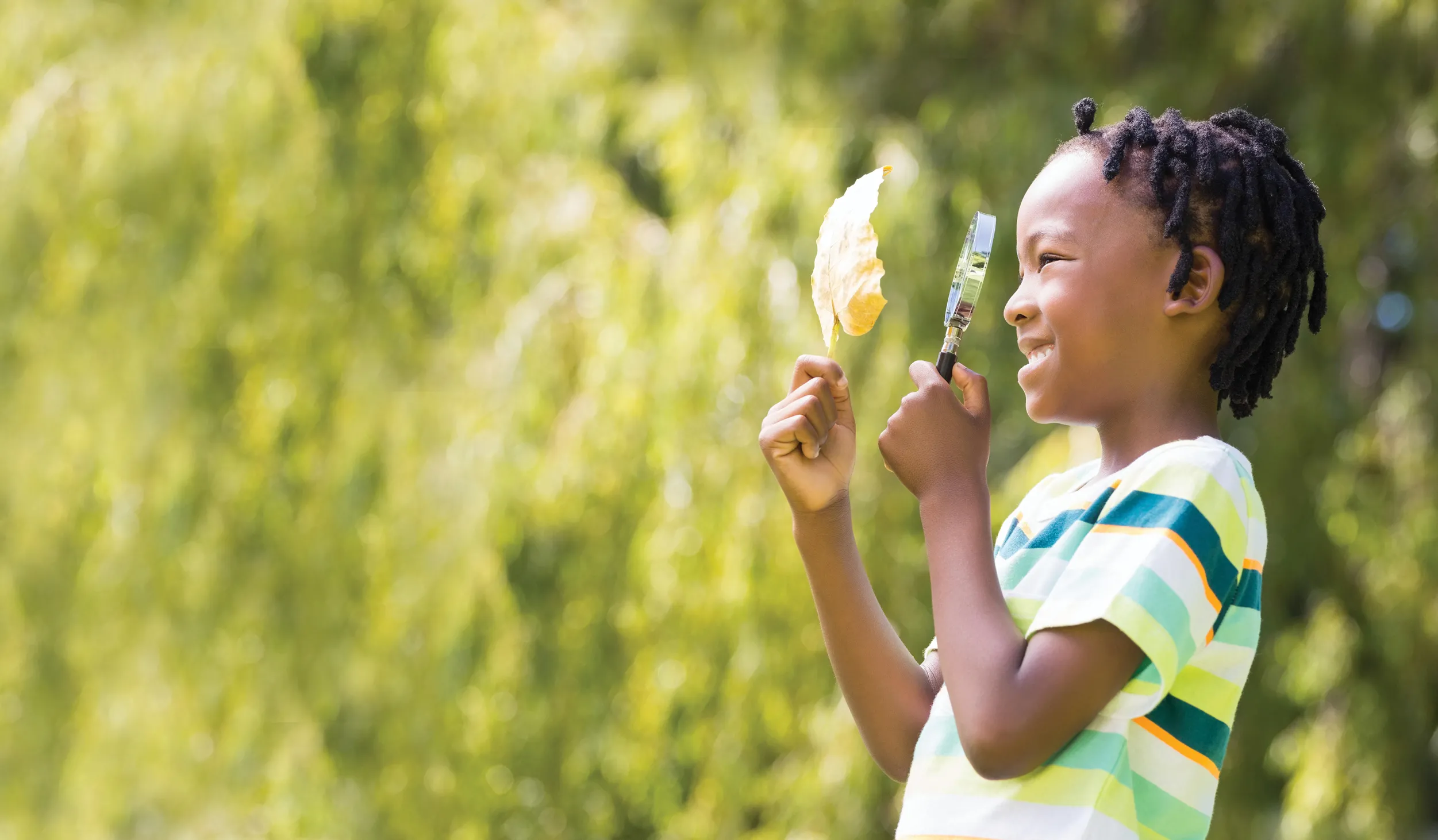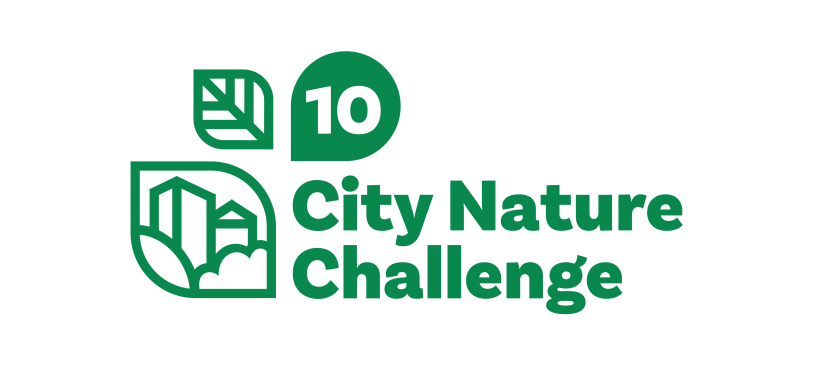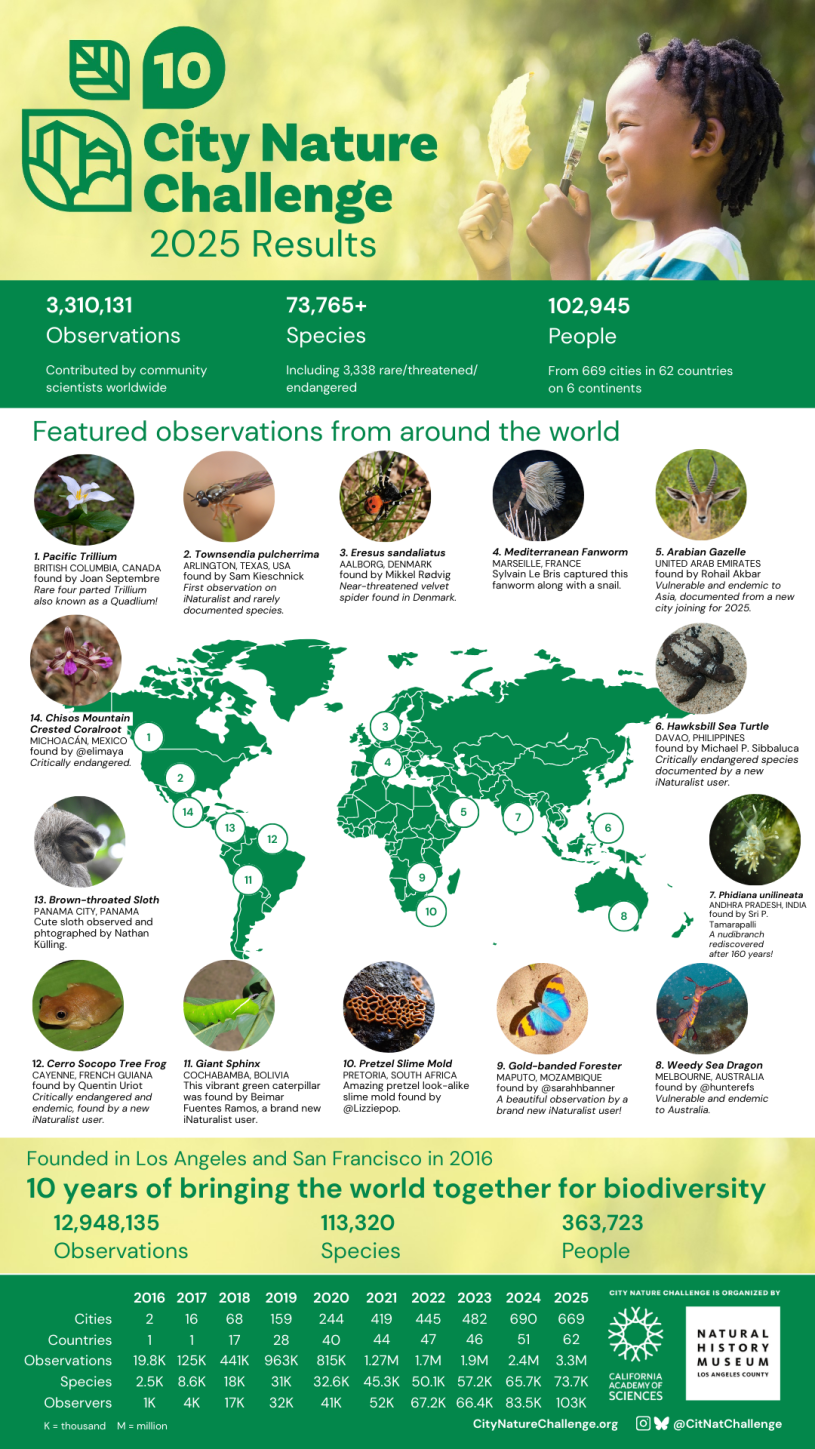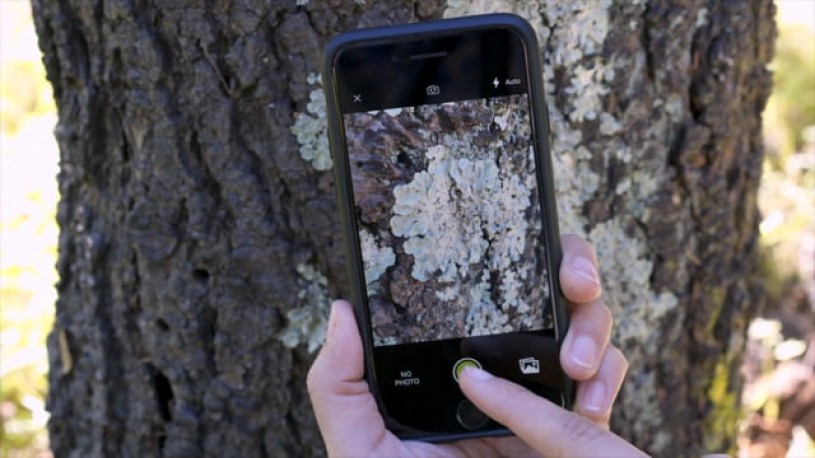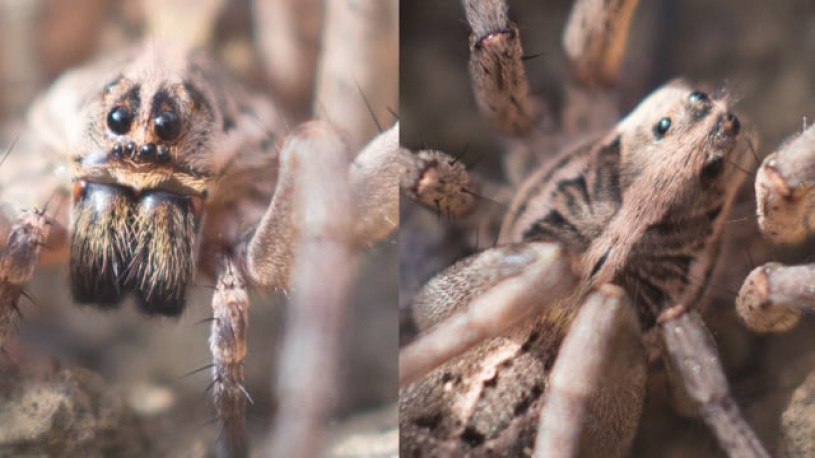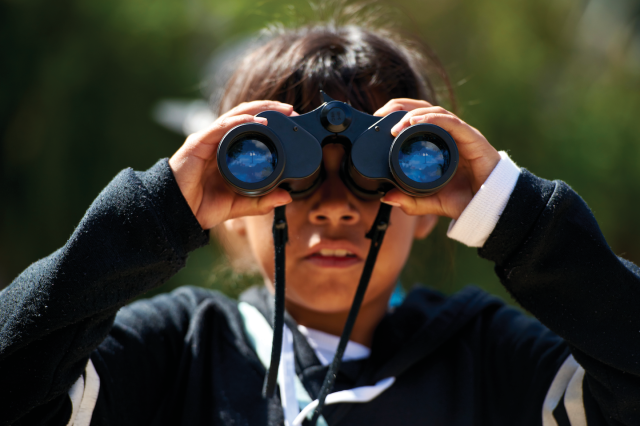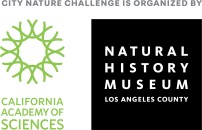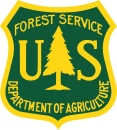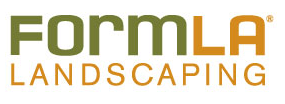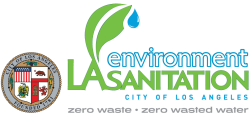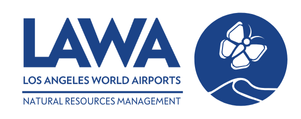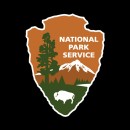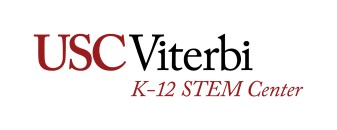2025 City Nature Challenge
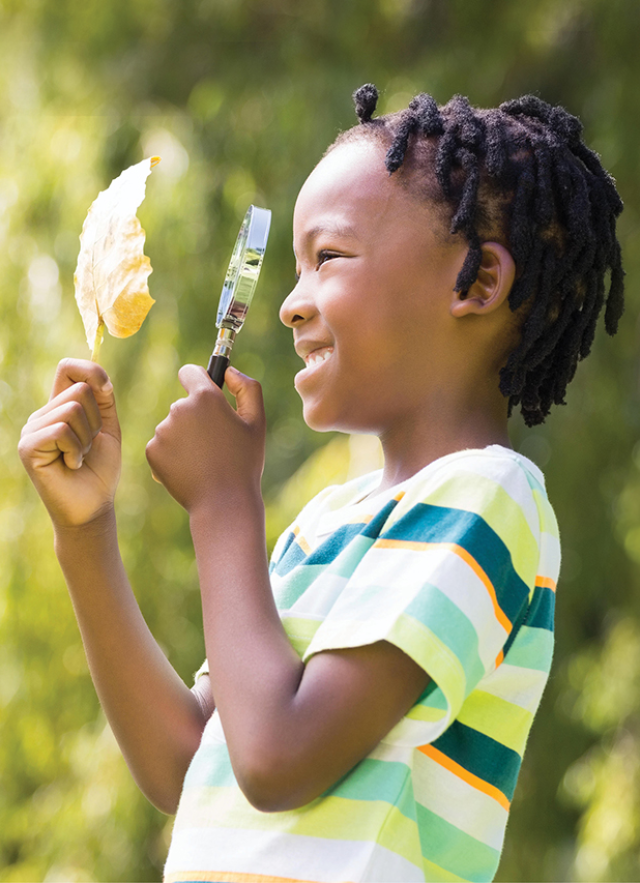
City Nature Challenge 2025 Results
In 2025, the City Nature Challenge (CNC) celebrated its 10th anniversary with amazing results! What started in 2016 as a competition between Los Angeles and San Francisco has become a global community science event, increasing participation in science and conservation. The impact of the City Nature Challenge will be felt for many years to come, especially as people continue to identify this year’s submissions, increasing the percentage of Research Grade observations, which contribute to the Global Biodiversity Information Facility (GBIF), and increasing the body of knowledge centered around urban biodiversity.
2025 Global Totals
- Observations: 3,310,131
- Species: 73,765+, including more than 3,338 rare/endangered/threatened species
- People: 102,945
- Most observed species: Common Dandelion (Taraxacum officinale), with 8,617 observations
- Number of participating countries: 62
- Number of participating cities: 669
Click here to view all results.
AND DRUMROLL PLEASE, here are our Global 10-year anniversary results:
In 10 years, the City Nature Challenge has generated more than 12,000,000 observations worldwide!
- Observations: 12,948,135
- Species: 113,320, including 7,138 rare/endangered/threatened species
- People: 363,723
- Most Observed species: Mallard (Anas platyrhynchos)
2025 Los Angeles Totals
- Observations: 27,067
- Species: 2,803, including 88 rare/endangered/threatened species
- People: 1,514
- Most observed species in Los Angeles County: Western Fence Lizard (Sceloporus occidentalis)
Since its beginning in 2016, more than 10,730 Los Angeles County residents have made 216,966 observations and documented more than 5,549 species!
See below for some interesting and fun finds from around the world!
Los Angeles Highlights
Putting the “City” in City Nature Challenge
- A common raccoon (Procyon lotor) caught reaching through a fence to grab food out of a container. -observed by two iNaturalist users–heleena2 and bdimare
Rare, Endangered, Threatened, or Endemic
- A Hemphill's Westernslug (Hesperarion hemphilli) which, according to NHM’s Malacology Curator Jann Vendetti’s comment in the observation, "That's one of our hard-to-find natives! Arguably, the only native slug to LA County!!" -observed by iNaturalist user rochellekhoffman
- A great photo of a white pygmy-poppy (Canbya candida) an endemic plant in California, that has limited distribution and is fairly threatened in California, according to the California Native Plant Society. The observer has set a penny behind the tiny plant to show scale. -observed by iNaturalist user keirmorse
- A San Clemente Island Fox (Urocyon littoralis ssp. clementae), which is listed as near threatened on the IUCN Red List. This particular subspecies is endemic in Los Angeles County. In this year’s City Nature Challenge, four subspecies of island fox were observed, all on different Channel Islands, highlighting the role of islands in isolating populations, which can lead to species differentiation over time. -observed by iNaturalist user arielg
I Found My Thrill on Elephant Hill
- A mating pair of southern alligator lizards (Elgaria multicarinata) according to NHM Herpetology Curator Greg Pauly, this has been a dry year and had the driest start to the rain season on record in Southern California, which has led to lower than usual sightings of mating alligator lizards. This observation is particularly exciting because it happened during the Museum's Elephant Hill Community Nature Celebration and Habitat Survey, which was put on with partners Save Elephant Hill, Coyotl + Macehualli, Heroes of Elephant Hill, Test Plot, Anawakalmekak, Northeast Trees, and Audubon Center at Debs Park. -observed by iNaturalist user hogpotato
Hard to Identify
A bee (not yet ID’d to species) which has generated conversation on iNaturalist based on its morphological characteristics, making it difficult to classify and identify to species.
-observed by iNaturalist user fowliviaSpotted by Youth
- A brahminy blindsnake (Indotyphlops braminus) According to the user’s comment in the observation, “I work at a preschool and the kids found this amazing creature!” The brahminy blindsnake is a small snake commonly mistaken for an earthworm and introduced to Los Angeles County. According to Wikipedia, it is the smallest known snake species, and its eyes are covered with translucent scales, which limit vision. The keen-eyed preschoolers who spotted the tiny snake surely had their nature eyes on! -observed by iNaturalist user capercaillie_clover
That’s a Lot of…
- Millipedes (not identified to species yet) That’s a lot of legs! A mass of millipedes observed by a new iNaturalist user at NHMLAC partner, LA County Parks, Whittier Narrows Natural Area in South El Monte. - observed by iNaturalist user damien151536
- Canada goose (Branta canadensis) That’s a lot of babies! More than 50 goslings crowd near an adult Canada Goose at Echo Park while two other adult geese float nearby. Large groups of goslings like this are called a crèche, where multiple adults care for groups of young.
-observed by iNaturalist user lunaraura
Fabulous Photos
- Double-crested cormorant (Nannopterum auritum) This double-crested cormorant performs a high-wire act, balancing on one foot.
-observed by iNaturalist user ki6h - Mariposa lily A gorgeous, and beautifully lit photo by a new iNaturalist user of an endemic and vulnerable flower with Catalina harbor in the distance. (The species is not yet confirmed, though likely Catalina Mariposa Lily), which has limited distribution and is fairly threatened in California according the the California Native Plant Society. -observed by iNaturalist user eb29817
Mark Your Calendars for the 2026 City Nature Challenge
April 24 to April 27, 2026
The City Nature Challenge is an international effort to document nature in cities. The global event calls on current and aspiring community scientists, nature and science fans, and people of all ages and backgrounds to get outside and observe and submit pictures of wild plants, animals, and fungi during the Challenge dates in order to help scientists track real-time changes in our planet’s biodiversity and better understand wildlife conservation.
How to Participate
Download the iNaturalist app from the App Store or Google Play.
Step 1: Find wildlife anywhere in L.A. County (or your local area).
Step 2: Take photos of WILD** plants & animals.
Step 3: Share Your observations in the iNaturalist app. If it's planted or taken care of by people it is not WILD. Mark it captive/cultivated!
Step 4: Learn more as your finds get identified.
**Wild means not captive or cultivated. Try not to take pictures of captive animals in zoos or aquaria and cultivated plants in your garden or at a nursery.
iNaturalist How-To Videos
Adding an Observation on a Mobile Device
Adding an Observation via the Web
How to Take Identifiable Photos
The City Nature Challenge is brought to you by the Natural History Museum of Los Angeles County and California Academy of Sciences.
